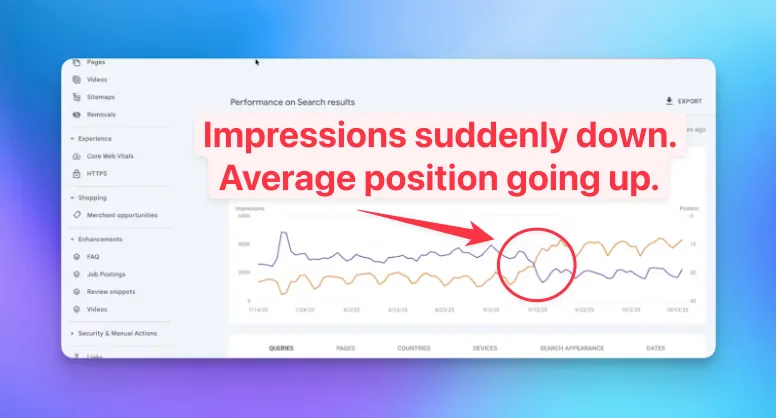If you saw a drop in some GA4 metrics last month, you’re not alone. There’s a simple but technical reason for the sudden shift.
Google changed their “num=100” parameters.
👆Instantly bored by that statement? I see you. And I am here to translate this very dry topic into bottom-line marketing terms for you.
Let’s talk about what this num=100 is and how you should talk about it with your team.
TB;CR (Too boring, can’t read)
Big-picture summary:
- The num=100 parameter allowed people (especially bots) to see 100 search results at a time.
- Google recently disabled that parameter.
- How it affects marketers: some key performance metrics are going to suddenly change course.
This is more a reporting issue than an actual performance issue. Metrics that might look suddenly very different in your GA4 reports:
- Fewer impressions. Because bots can no longer see the top 100 results for a search term, your page that ranks #77 for a search term is going to make fewer impressions.
- Increased click-through rate. Since the number of impressions is going down for poor-ranking content that hardly ever gets clicked anyway, the overall click-through average will go up.
- Increase in overall position. Similarly, because those poorly ranking pages are factored in less frequently, your average position will go up.
If you’d like the video version of this run-down, voila:


What this num=100 actually does
Allow me to explain via example. I just did a google search for “electronic vehicle.” Google will show me the top results in the SERP.
It’s not an infinite scroll. It’s a finite number – typically around 10 links.

To see more, you have to click to the next page of SERP results.
When any of us casually search like this, the finite number of results is not any big inconvenience. But for certain data products that scrape Google search results, this limitation is a cost consideration.
SEMrush, for example, runs searches and collects the data. If their bots could only see 10 results at a time, the data collection process would be much less efficient (and more expensive).
So they use the num=100 trick. It’s a little snippet of code that you can put in the URL so that Google shows you 100 page results at a time. No additional clicking (or API calls) required.
This num=100 trick made it really easy for tools like Ahrefs to see the #1 ranking post as easily as they saw the #93 ranking post, all in one motion. And this is the practice that Google just suddenly made impossible.
The “num=100” move no longer works.
How this affects your performance metrics
When it comes to organic search impressions, our clients’ GA4 reports suddenly look like this one:

Impression volume is looking strong and then suddenly, around late September 2025, Google makes the change to “num=100” parameters and down goes the impression count.
Impressions volume drops
In some instances it drops by about 40%.
This is happening because crawlers aren’t going through SERP results as extensively as they used to. Crawlers aren’t seeing anything beyond the first page of the SERP. They can’t see your #93 ranked page in one motion and so they’re seeing it much less frequently. As a result, that page is registering fewer search impressions.
So that trend chart shown above looks mighty disappointing.
Lots of the impressions that you lost were being triggered by bots all along. They were never going to result in clicks. So this is really just getting rid of some sketchy data points.
The upside for marketers
Here’s one upside: the average click-through rate is going up. It’s not a meteoric change – but, in this example below, it’s a steady upward trend.
(👇 Impressions are the purple line, click-through rate is the green line.)

Average position increases
The other thing that you're going to see: impressions went down and average position goes up.
(👇 Impressions are the purple line, average position is orange.)

Why is this happening? Because the impressions that went away with the “num=100” change were impressions for your lower-ranking pages.
Those lower-ranking pages are not being seen as frequently as they were before. So those pages ranked #90 have become a much smaller factor in the overall calculation for average position.
Do you need to worry about this num=100 stuff?
Not in a commercial sense. You might think of it primarily as a change in reporting. In one sense, the end of num=100 means some more accurate overall data.
Keep an eye on it. Let the rest of your team know what’s going on so they’re not shocked when they happen upon that stark downward-trending impressions graphic.
You can tell them: it's a technical change. It shouldn’t affect our bottom-line. I know it's a little scary, but we're keeping most of the real impressions and clicks that we had before.
🙂

